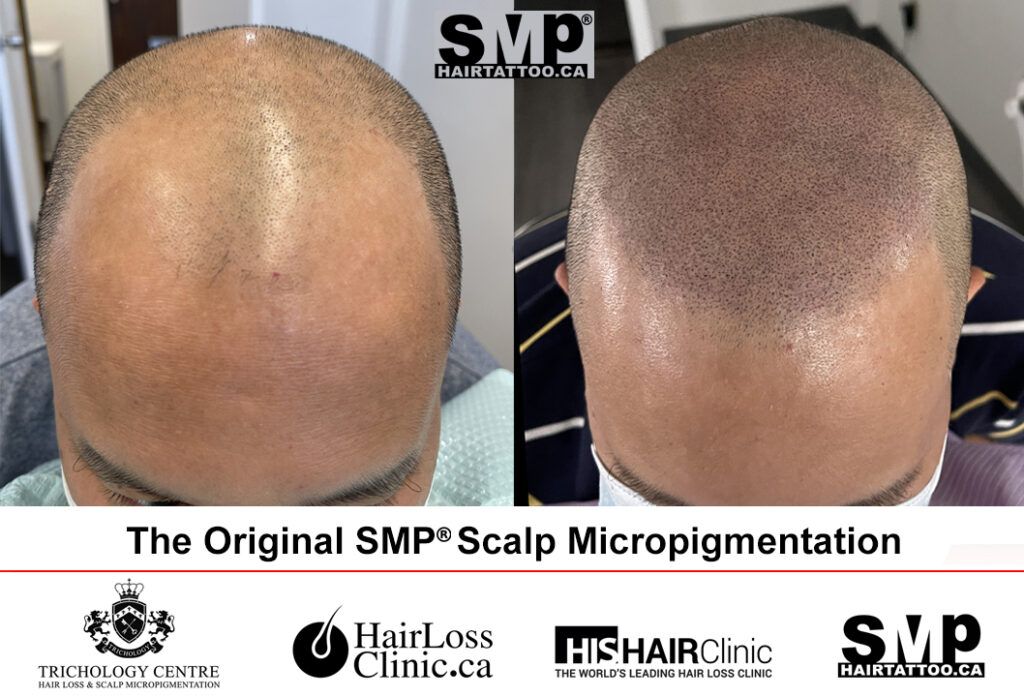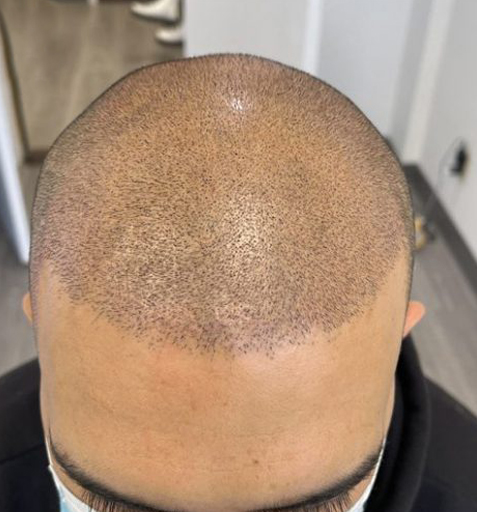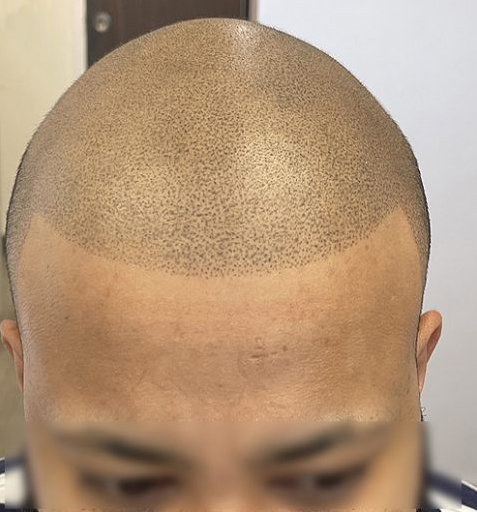
Table of Contents
Table of Contents
A blood test can help determine if any underlying conditions are causing hair loss. Minoxidil (Rogaine) is a viable treatment option for female pattern hair loss, the most common form of hair loss in women characterized by hair shedding. This FDA-approved medication is known to stimulate hair growth and is a popular choice among patients seeking to address this condition. On the other hand, male pattern hair loss is characterized by hair falling out, leading to a receding hairline and baldness. The cause of male pattern hair loss is believed to be a combination of hormones and genetics.
The treatment for male pattern hair loss includes the use of minoxidil (Rogaine) and finasteride (Propecia). Both of these treatments are FDA-approved and work to stimulate hair growth.
SMP is a form of cosmetic tattooing that works by placing pigment (ink) in the layers of the skin; similar techniques include microblading to fill out eyebrows and permanent makeup. SMP makes a stippled pattern on the scalp by placing microdots less than 1 mm in size, decreasing the contrast between hair and skin and creating the illusion of fuller hair.
Hair loss is a common concern for both men and women. Experiencing hair loss can be a source of distress and negatively impact one’s self-esteem. There are various hair loss types, each demanding a unique treatment approach. This article will delve into the different types of hair loss and the corresponding treatment options available for each.
Female Pattern Hair Loss: Androgenetic alopecia, commonly referred to as female pattern hair loss, is characterized by hair shedding, and is the most prevalent type of hair loss in women.
This condition leads to thinning of the hair on the top of the scalp, resulting in a widening of the parting line. While the exact cause of female pattern hair loss is not fully understood, it is believed to be a combination of genetics and hormones. To stimulate hair growth, minoxidil (Rogaine) is an FDA-approved treatment that can be used to treat female pattern hair loss.
Alopecia areata is a medical condition that results in the loss of hair in patches on both the scalp and other areas of the body. This condition is caused by an autoimmune response, where the immune system attacks hair follicles
This condition includes different types, such as alopecia totalis and alopecia universalis, which result in complete hair loss on the scalp or the entire body. One could rephrase it as: Alopecia areata, which results in hair loss due to an autoimmune disorder where the immune system attacks hair follicles, has a treatment option called topical immunotherapy.
While there is no known cure for alopecia areata, topical immunotherapy can stimulate hair growth in some individuals. Corticosteroids can also be injected into the scalp to reduce inflammation and promote hair regrowth.

There are several types of hair loss, including telogen effluvium, traction alopecia, and androgenetic alopecia, each requiring different treatment approaches. Telogen effluvium is characterized by hair shedding caused by stress, medication, or hormonal changes, while traction alopecia is hair loss caused by pulling the hair too tightly.
Hair loss treatments encompass several options, such as hair transplants that involve relocating hair follicles from one area of the scalp to another, and scalp micropigmentation, a cosmetic procedure that creates the impression of a full head of hair by tattooing tiny dots on the scalp.
It is imperative to consider the risks and benefits of each treatment and consult with a healthcare provider to determine the best approach. It is crucial to discuss the risks and benefits of each treatment option with a healthcare professional before proceeding.
Other types of hair loss may be treated with hair transplants or scalp micropigmentation. It is important to consult with a healthcare professional to determine the best treatment approach for hair loss. With the right treatment, hair regrowth is possible, and one can restore their confidence and self-esteem.
Scalp micropigmentation uses tattooing techniques to camouflage thinning hair by decreasing the contrast between skin and hair. It usually requires three sessions, one week apart for each session, with each session lasting one to two hours.
SMP treatment for hair loss can cost anywhere from $3000-$4000 per session. Finding a qualified SMP tattoo artist is essential, as the quality of work varies from clinic to clinic. His Hair Clinic | Hairtattoo.ca is a reputable clinic with 3 locations in the Toronto area, downtown Toronto, Richmond Hill, and Mississauga. His Hair Clinic invented the procedure almost 20 years ago and is world-renowned as a leader in scalp micropigmentation.
Scalp micropigmentation uses standard tattooing instruments with several microneedles to create the stippling on the scalp. It is crucial to have a skilled tattoo artist performing the SMP. Every patient is different, and the skin on the various parts of the scalp is not the same, so the tattoo artist needs to be able to make technical and artistic changes as he or she performs the procedure. If the pigment is placed too deep, it will become blotchy; if it is too shallow in the skin, it will bleed out and fade more quickly.
FREE ONLINE HAIR LOSS ASSESSMENT FORM AT THE HAIR LOSS CLINIC HERE
The SMP tattooing process does cause some irritation, and you should not have it done if you have inflammation in your scalp, like scalp acne, eczema, or psoriasis.
SMP does not treat the various causes of hair loss. Instead, it camouflages the thinning hair by decreasing the contrast between skin and hair; it is a cosmetic procedure.
To minimize these risks, make sure that you seek out a competent practitioner. There is no specific nationwide certification for SMP. In some areas, little to no training may be required before someone can perform SMP. Since it is a complicated process that involves adjusting techniques based on your skin, you should consult someone with a lot of experience with SMP.
Scalp micropigmentation is a non-surgical hair loss treatment that simulates hair follicles by depositing microscopic pigments into the scalp. SMP has gained popularity as a safe and effective treatment for various hair loss conditions, including male and female pattern baldness and alopecia, in both men and women.
This innovative procedure involves depositing pigments into the scalp using a microscopic needle to simulate the look of hair follicles, providing a natural and realistic appearance. Whether an individual is experiencing hair loss due to genetics, aging, or medical conditions, SMP can be a viable solution for restoring their confidence and self-esteem.
In addition, the treatment can be tailored to obtain a natural look that complements the individual’s hair colour and skin tone. Traditional hair loss treatments, such as medication and hair transplants, necessitate routine upkeep and unnecessary maintenance with SMP. Additionally, the procedure can provide a less expensive alternative to hair transplant surgery.
Overall, SMP is a versatile and effective method for restoring the look of a complete head of hair. For more information about SMP treatment for hair loss, visit https://hairtattoo.ca, or if you are losing your hair, please fill out our FREE ONLINE HAIR LOSS ASSESSMENT FORM AT HAIR LOSS CLINIC HERE






© 2024 HAIRTATTOO.CA | Scalp Micropigmentation & Trichology Centre
